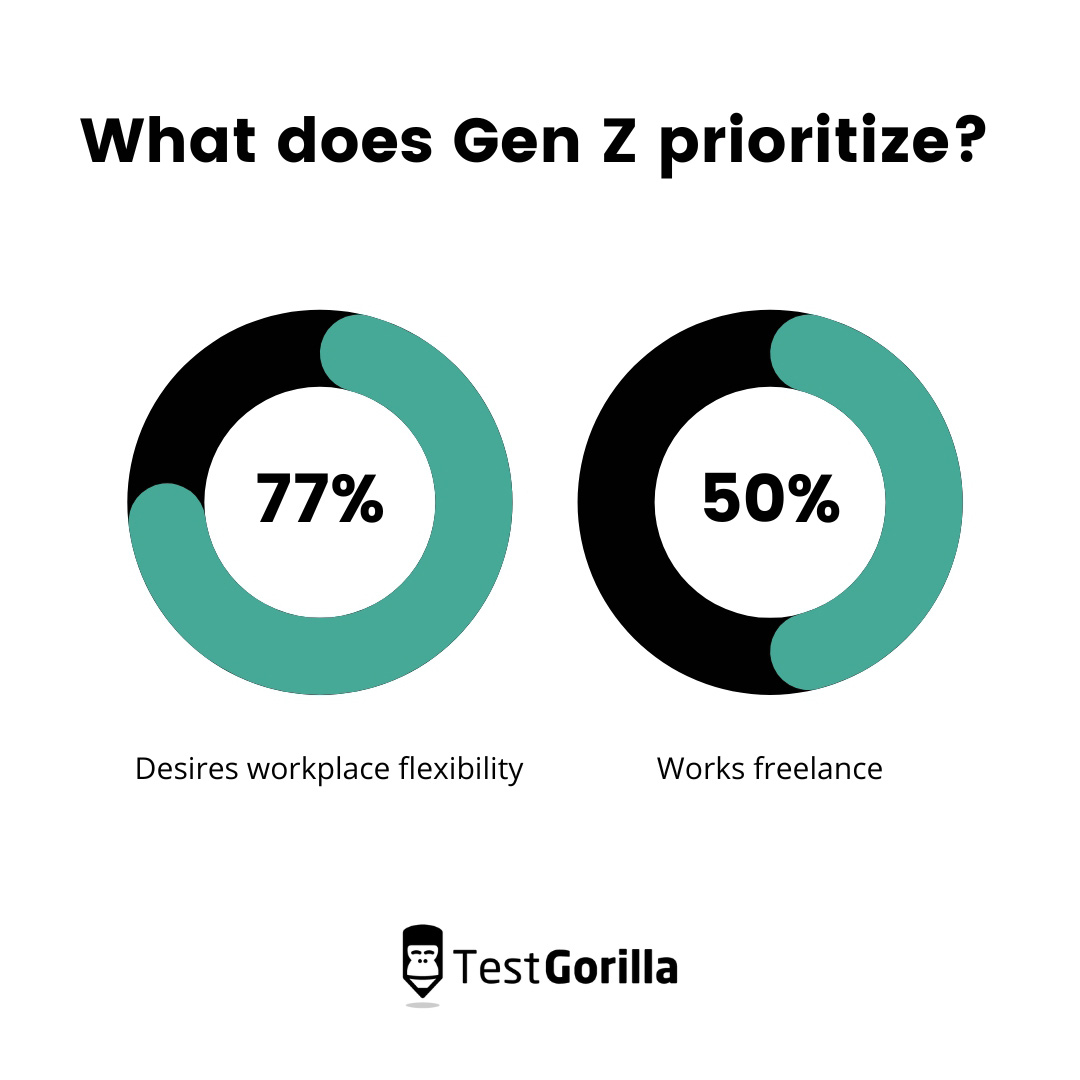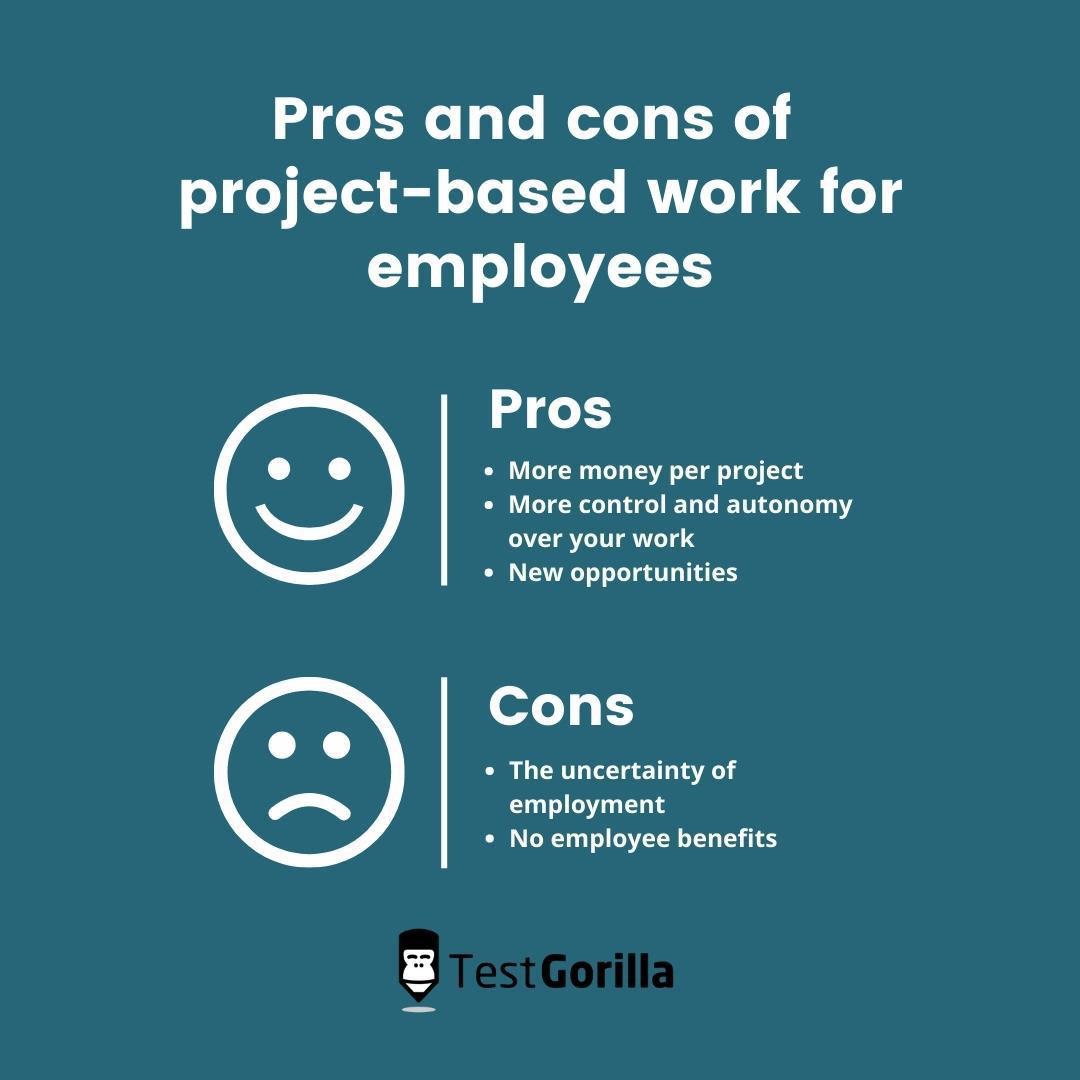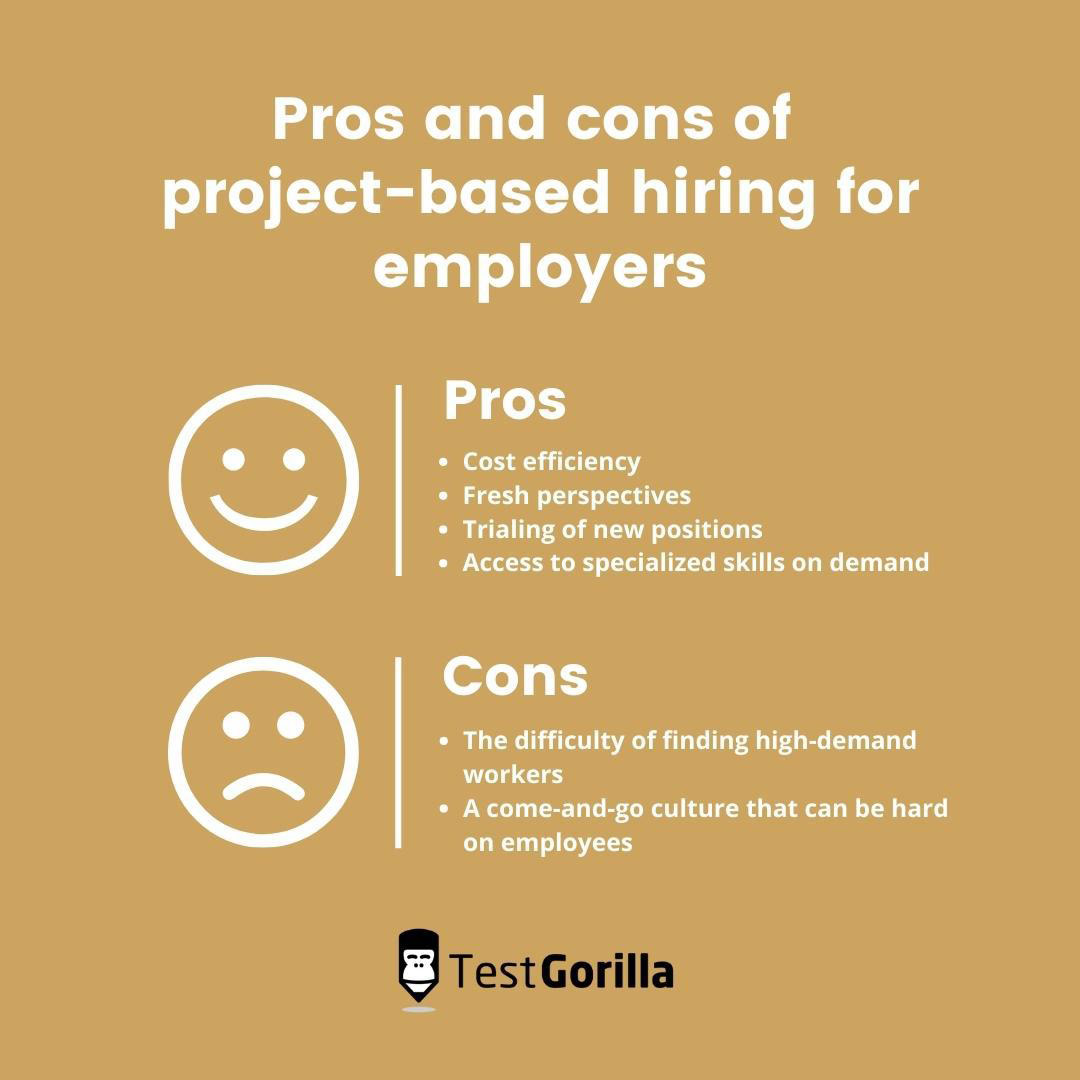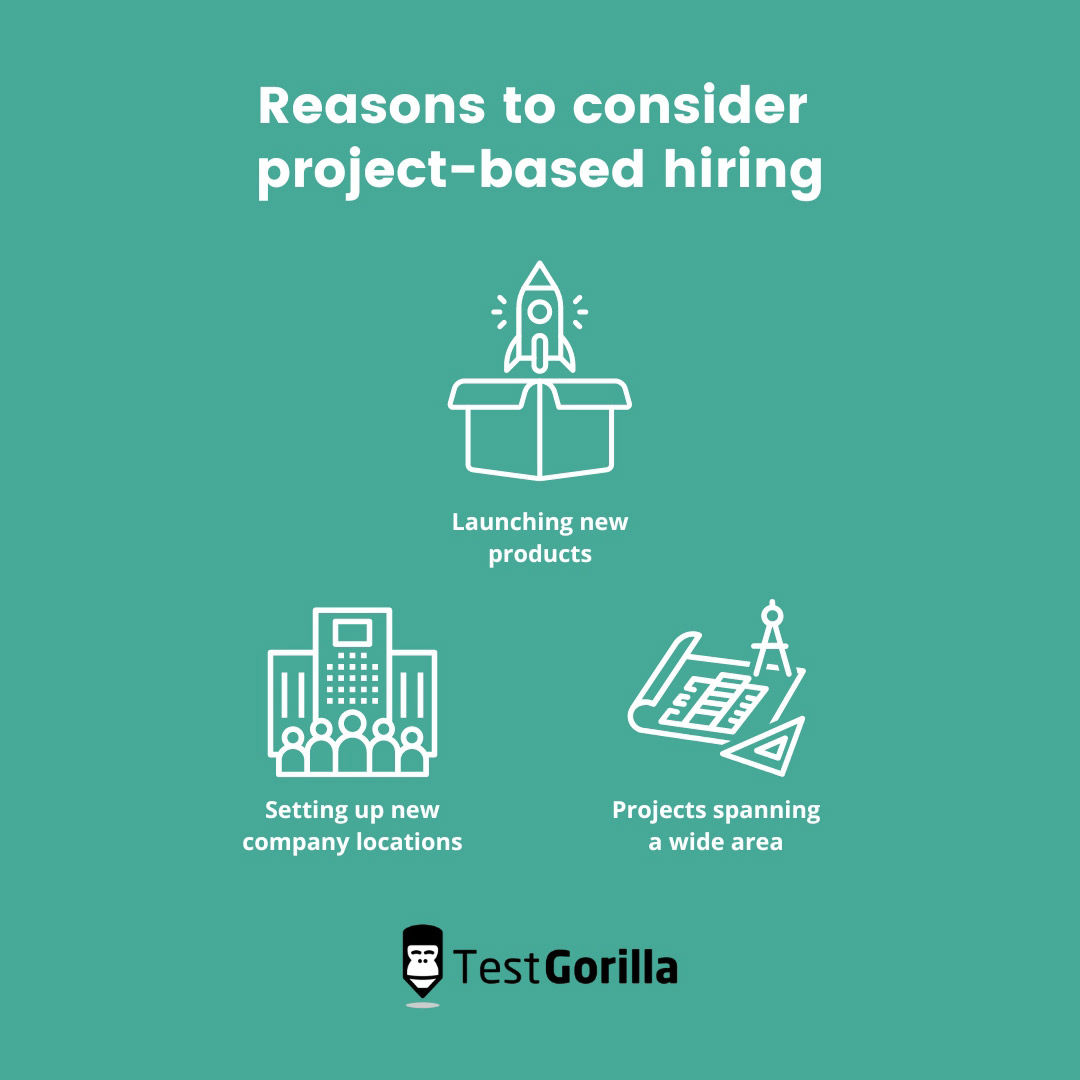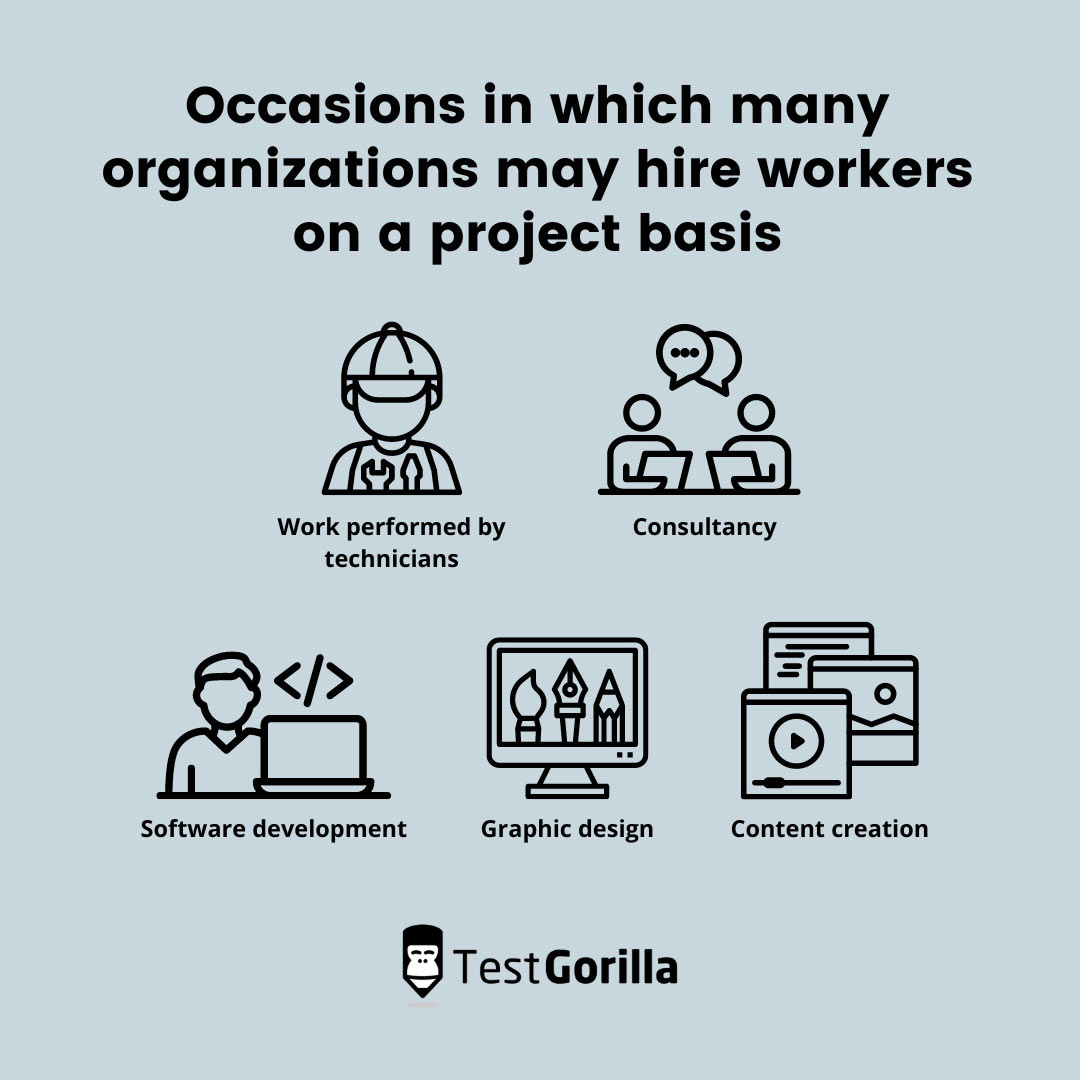The project-based workforce is growing rapidly.
It contains some of the best talent available – those with highly specialized skills (e.g., Python coding) are increasingly opting for contingent and contract-based work.
And more and more organizations are adapting project-based hiring to fill critical roles faster, spending less and accessing more diverse talent. According to a 2020 study, 80% of large corporations plan to increase their use of flexible, project-based workers.
SMEs are also becoming aware of the many benefits of using freelancers and are opening their doors (and minds) to hybrid workforces.
But saying it and doing it are two different things. How do you implement project-based recruiting in your hiring strategy?
This step-by-step guide details how to begin project-based recruiting in your company and covers the pros and cons for both employees and employers.
What is project-based hiring?
Project-based hiring is when an organization hires a worker for a specific project instead of a full-time employee.
These projects have clearly defined goals and deliverables for the worker to meet, and there is no obligation or expectation for the relationship to continue after the project is complete.
This is also called short-term hiring or contingent hiring.
Companies consider project-based hiring for many reasons. Some of the most common are:
Launching new products
Setting up new company locations
Projects spanning a wide area (i.e., 9 locations across 6 U.S. states need new tech)
So what does project-based recruitment mean for the company and the worker?
Company | Workers |
For companies, project-based hiring means: Cost efficiency; Rapid, easy scaling; Easy access to specialized skills | For workers, project-based hiring means: Flexible, autonomous work; They can choose projects that suit their skillset; Varied opportunities |
Increasingly, more companies are adopting project-based hiring in the modern age, for the reasons above and many more.
Let’s talk about the current state of contingent work.
Is project-based recruitment the future of work?
Project-based employees are a part of the gig economy, which is a labor market composed of short-term contracts and freelance work.
The gig economy has a firm place in the future workforce – Uber, Fiverr, Upwork, Grubhub, Airbnb, and many more organizations have helped build the gig economy.
It’s a trend that was already rising, but the pandemic made an enormous impact. Many people needed new jobs after lay-offs, and many others simply needed a side hustle to supplement a shaky income.
Two critical factors are boosting the gig economy today:
An increasingly mobile workforce
Remote work/work on digital platforms on the rise
These factors become more crucial as technology advances and workers develop new desires and demands. For example, 77% of Gen Zers prioritize workplace flexibility, and 50% work freelance at least some of the time.
Opening yourself to project-based recruitment will significantly help when hiring Gen Z.
There’s also the rising want and need for worker autonomy. Modern workers want control over how, when, and where they work.
When workers say they desire job flexibility, they usually don’t mean “work from home two days a week.” Most workers who want flexibility want more autonomy over their job.
Pros and cons of project-based work for employees
Let’s cover the top benefits and drawbacks of project work from employees’ standpoint.
If you’d like to jump to the pros and cons for employers, go right ahead.
Pros | Cons |
More money per project; More control and autonomy over your work; New opportunities | The uncertainty of employment; No employee benefits |
Benefit: More money per project
A combination of in-demand skills and the ability to negotiate their pay means project workers tend to make more money than traditional employees.
Negotiating their pay means that a project worker can increase their rate when they believe their skills are worth more. Additionally, they can also leverage higher pay for projects that must be completed quickly.
A traditional employee, on the other hand, receives a set income each year regardless of the types of projects they work on, unless they ask the company for a pay raise and it’s approved.
Benefit: More control and autonomy over your work
The modern worker prioritizes autonomy and control in their career.
Many workers who say they want “flexible” work really mean they want autonomy.
Project-based employees have a stake in how, when, and where they work. They typically define their work hours, manage their work themselves, and control their place of work.
Their “place of work” may even be a coffee shop or a bookstore.
Benefit: New opportunities
Because they work on a by-project basis, these workers aren’t committed to a single company for years or decades.
This means project workers get new opportunities frequently and can try a variety of ventures to find their ideal niche or discover companies they may never have encountered.
Drawback: The uncertainty of employment
A traditional employee has more security, knowing they get a paycheck each week (or month) for the foreseeable future.
Project-based employees aren’t guaranteed to have work when a project ends. They have to be ready to search for a new gig (or, preferably, search before the current project is over) – or juggle multiple projects at once.
They are never 100% secure.
Drawback: No employee benefits
Contingent workers don’t receive health benefits, pensions, and other benefits that are part of the traditional employee’s work package.
To compensate, project workers may add a percentage to their pay rate (5-10% or more), but they still have the extra work of finding and managing their own health coverage.
The best insights on HR and recruitment, delivered to your inbox.
Biweekly updates. No spam. Unsubscribe any time.
Pros and cons of project-based hiring for employers
Now let’s cover the top benefits and drawbacks of project workers from the employer’s standpoint.
Pros | Cons |
Cost efficiency; Fresh perspectives; Trialing of new positions; Access to specialized skills on demand | The difficulty of finding high-demand workers; A come-and-go culture that can be hard on employees |
Benefit: Cost efficiency
Project-based recruitment is more cost-efficient for a few reasons.
Hiring traditional employees means you need to pay taxes, health benefits, time off, and other perks. You don’t have to offer any of these benefits to project workers.
Plus, recruitment costs less as you don’t go through a resource-intensive hiring and firing process.
Benefit: Fresh perspectives
Working with talent outside of your organization can offer you a fresh perspective.
Independent contractors have worked at various companies in many different situations, which gives them a wide range of ideas and perspectives.
They can also come with the expertise they’ve gained from competitors in your industry. This doesn’t mean they would share trade secrets, but they naturally bring new processes and ideas you can implement and learn from.
Benefit: Trialing of new positions
Using contingent workers is an excellent way to trial new positions before fully implementing them in the company.
A non-permanent employee will enable you to test a role’s responsibilities and requirements and get real-time insights.
You may even offer the position to the original project worker, which means you would have a pre-existing relationship to build on.
Benefit: Access to specialized skills on demand
Project-based hiring enables you to recruit workers with highly specialized skills on demand.
For instance, if a project requires a unique skill your workforce doesn’t have, you may need to train a current employee or hire a brand new one.
Both options aren’t ideal if you don’t expect the need for this skill to extend beyond the project.
Project-based hiring allows you to hire specialized talents for a short-term project much faster than the traditional hiring process.
Drawback: The difficulty of finding high-demand workers
Many specialized positions, such as IT technicians, are in high demand.
This means available talent on the market might be scarce, and it might be difficult to find the perfect contingent worker that checks every box and fits your company culture.
Drawback: A come-and-go culture that can be hard on employees
Longer contracts (six months to a year) mean a worker spends a long time in your organization, bonding with teammates, before suddenly being gone.
This come-and-go culture can be hard on your employees, possibly leaving them disengaged and unmotivated.
Is project-based hiring right for your organization?
Now, to the key question.
When should you move towards project-based recruitment?
Here are a few occasions in which many organizations may hire workers on a project basis:
Work performed by technicians
Consultancy
Software development
Graphic design
Content creation
Project workers can fill most positions.
The key consideration is adapting your recruitment strategy and employee management to match contingent workers.
Many companies take on contingent workers without changing their processes to accommodate them. However, current practices such as workforce planning, compensation policies, talent acquisition, and performance management mainly cater to traditional employees.
What does this mean for your organization?
It means that project-based hiring could greatly benefit your company, as long as you plan the process carefully.
If you intend to make project-based hiring a regular part of your strategy, you’ll need to adapt your approach, shift your strategies, and create a new way to hire and manage workers.
We can help with that part.
How to implement a project-based hiring approach
If you want to adopt project-based recruitment, you’ll need a new approach specifically suited to the project-based workforce.
It isn’t a process you can skip, but it isn’t too difficult, either.
Let’s get started with a quick summary…
Step | Description |
1. Evaluate roles | Assess which roles would be best for project workers |
2. Evaluate ROI from each approach | Consider which approach would be the most cost-effective depending on the role |
3. Check your tech stack | Update your tools and tech to manage a project-based workforce better |
4. Integrate project workers into your workforce | Check if some of your current employees would like to switch to a project-based system and integrate your new project workers with traditional employees |
5. Streamline and strengthen your hiring process | Update your hiring process to accommodate project-based recruiting better |
6. Set clear expectations | Clarify what you expect from your contingent workers and leave nothing unsaid |
7. Conduct risk assessment and mitigation | Consider and identify the possible risks that come with project-based recruitment |
… Before describing these seven steps in greater detail.
1. Evaluate roles
The first step is to examine your roles and determine if they can be project-based.
The amount of firm-specific knowledge a role requires is a huge factor.
While a freelance or contract worker may possess equal (or even greater) talent than some traditional employees, if a position requires deep internal knowledge, it might not be the best role for project-based work.
Why? A contract worker would have to learn a large amount of business-specific knowledge only for a short-term gig, using up their time and yours.
Another factor is whether this task is recurring or not. If you periodically need to hire a new person to tackle it (or re-hire contingent workers you’ve worked with previously), it may be more suited to a traditional employee.
On the other hand, if it requires little specific company knowledge, you might still consider it to be a great fit for a project-based employee.
Dig into your roles, assess their requirements, and make an educated decision on whether or not a project worker could be the right match.
2. Evaluate ROI from each approach
Project-based hiring is famously cost-effective, but that doesn’t mean this applies to every role in every company.
Let’s continue with the example above.
If you have a role with a large amount of firm-specific knowledge required, your costs will be much higher for a contingent worker. Hiring a project worker for this role will require extensive training and onboarding that you’ll have to repeat the next time you fill the role.
At the same time, you only need to train and onboard a traditional employee once.
On the other hand, if this role requires highly specialized skills and low firm-specific knowledge, your ROI will be much higher if you recruit a project-based employee. This solution will cost you less than hiring a new traditional employee or upskilling a current employee and reprioritizing their existing tasks.
Take some time to fully evaluate the effort, resources, and cost associated with using either a traditional and a contingent approach and decide on the best method for each role.
It’s well worth your time.
3. Check your tech stack
Review your tech stack – are you ready for project-based hiring?
There are many tools available that can streamline project-based staffing and make it a more efficient, enjoyable process:
Talent acquisition analytics software to analyze your hiring processes so you can fill roles more efficiently
Communication software (such as instant messaging apps) to keep everyone in the loop
Pre-employment screening tests to assess the skills of your project-based employees and ensure a good fit
Online skills testing is one of the best ways to assess a project-based candidate. Many project workers don’t rely on CVs and resumes but rather just have a talent they’re monetizing.
For example, if you need to hire a programmer for a one-off project, a candidate might be an excellent fit even if they have no formal qualifications.
You can prove this candidate’s skill through a series of programming tests, such as:
Screening tests will help you confirm the candidate’s skill without the need to ask for formal credentials.
Communication software is another essential in your project-based staffing tech stack.
One of the biggest pitfalls in companies’ relationships with contingent workers is poor communication, so an easy-to-use messaging app is critical.
Ensure you also set concise communication guidelines within the program – for example, you might have specific channels for certain topics and issues. Outlining specific communication guidelines will keep every project worker speaking to the right person about the right topic.
We’ll touch on communication guidelines again in step 6.
4. Integrate project workers into your workforce
Would some of your current employees switch to project-based work?
When implementing project-based staffing, check to determine if some of your current employees are interested in switching to project-based employment.
Most often, they won’t. If this is the case, you must determine how you will manage the divide when some of your workforce is role-based, and some is project-based.
It’s telling that 87% of companies include external workers when considering their workforce composition. So project workers are firmly considered a part of an organization’s workforce.
However, it’s important to ensure that the workers feel the same way.
Assimilating the two groups is crucial for collaboration, productivity, and for each worker to reach their full potential. The more workers feel included, the more engaged they’ll be.
Here are a few tips on how to integrate contingent workers:
Have traditional employees coach and mentor project workers
Give project workers performance reviews, feedback, and rewards for good work
Include project-based employees in team-building exercises
Above all, be aware of any rising divides in your workforce and be mindful of any possible “outsider/insider” culture that’s forming.
You need to create a sense of camaraderie throughout your workforce, whether project-based or not.
5. Streamline and strengthen your hiring processes
Certain hiring practices are better suited to recruiting project-based talent and will make your job easier and more effective.
Many companies use freelance job boards when searching for project workers. Great contingent talent commonly offer their services on websites like FlexJobs, Monster, and Indeed.
It’s also worth integrating social networking into your hiring process since contingent workers are accustomed to finding clients on social media websites such as LinkedIn.
Another way to optimize your hiring strategy for project-based staffing is to make your job ads concise and mobile-friendly – and to shorten your application process.
Many project workers are looking for work on their mobile devices and want the option to apply quickly and efficiently. Additionally, many might be put off by a lengthy hiring process and won’t apply if there are too many hoops they need to jump through.
6. Set clear expectations
Just because a worker isn’t a permanent employee, this doesn’t mean they shouldn’t have clear guidelines and goals.
In fact, they need them more than anyone. A project worker may have several active jobs, so clarifying expectations early on is necessary and appreciated on both sides.
Here are a few things to clarify with contingent workers to let them know what you expect of them:
Boundaries
Job description
Work scope
Time estimation and deadlines
Communication guidelines
The last point is crucial ground to cover. Explicitly state when they should communicate with the appropriate people – f.e., when they finish the job, when they hit a roadblock, or when they’re at risk of missing a deadline.
Too often, people think these things “go without saying.”
We say that nothing goes without saying.
7. Risk assessment and mitigation
Opening your company to project-based recruitment has many benefits but also opens you up to some possible risks.
This could include financial, legal, tax, and brand-image risks.
Most risks stem from non-compliance with contingent workforce-related laws, such as misclassifying a project worker as a traditional employee. Risks also include unlawful background checks, improper termination, and improper management of safety certifications.
These could lead to fines, penalties, and damages to your organization’s brand image.
It’s also important to secure your company’s privacy and IP with NDAs and other legal agreements.
Always seek legal advice from a law professional before going ahead with new hiring plans.
It will keep your organization and your workers safe and secure.
Project-based recruiting: a new approach to hiring
Project-based hiring isn’t a flash in the pan – it’s here to stay.
Adopting project-based recruitment will open your organization to new opportunities, specialized skills, and diverse talent.
It definitely requires its unique process – you cannot copy-paste your hiring strategy verbatim. But taking the time to tailor a recruiting strategy to your new workforce will be well worth the effort.
Setting clear expectations, considering risks and legal matters, and implementing online skills testing will streamline your project-based recruitment for everyone involved.
For more information on the topic, read our articles on hiring contingent workers and how to hire a freelancer for your company.
You should also check our Communication test and use it as a springboard for your project-based hiring strategy.
You've scrolled this far
Why not try TestGorilla for free, and see what happens when you put skills first.


